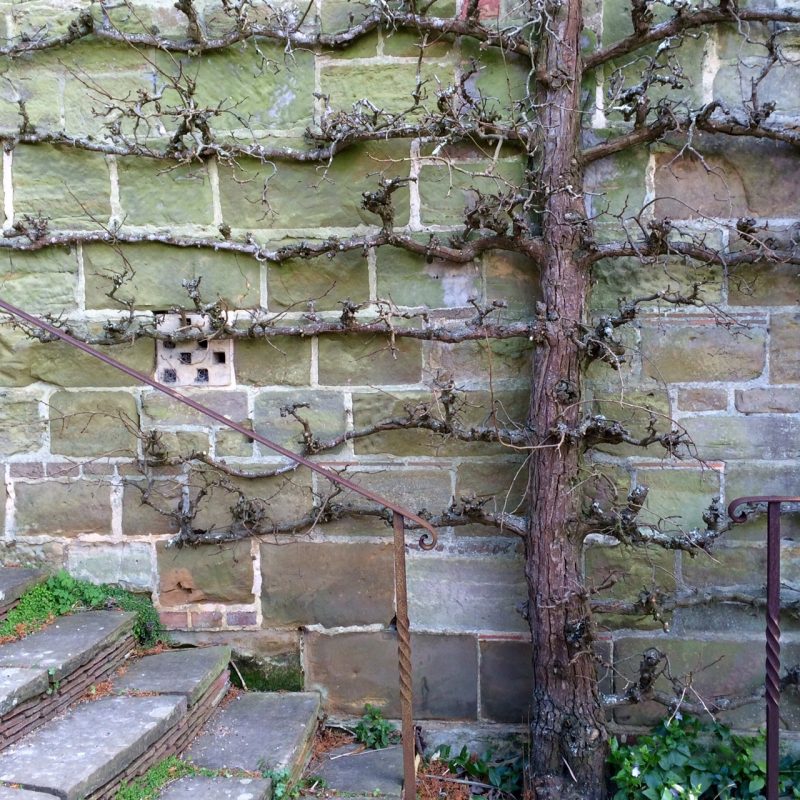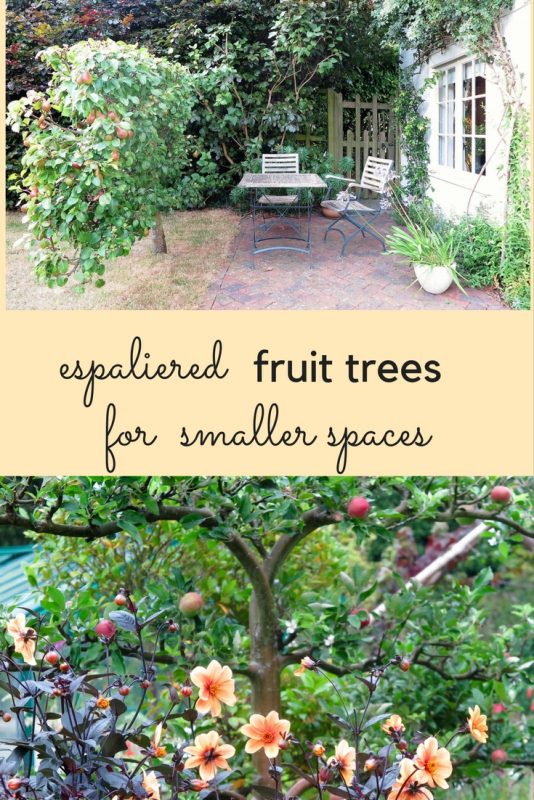Espaliered fruit trees are probably the smartest trees to look at in winter, with their tailored elegance.

As smart as anything from a Saville Row tailor – an espaliered pear at Great Dixter in February.
And in summer, they’re good space-savers for middle-sized gardens. Espaliered fruit trees offer lots of fruit while taking up relatively little garden ground.
They can cover walls and fences, using space that otherwise isn’t productive.
Or they can be free-standing, dividing up the garden or creating a screen.
The time to plant your espaliered fruit trees is technically between November and March, although these days, pot grown trees can probably be planted any time.
However, the window for pruning your espaliered apple or pear trees is definitely in January or February. That’s when you define and refine the shape.
So I went to Brogdale near Faversham, home of the National Fruit Collection and Grow, the nursery attached, to talk to head nurseryman, David Morrice, about espaliered trees.
Fruit trees getting more popular
At Grow, they’ve noticed a distinct increase in people buying fruit trees over the past few years. The main trend is towards having as many fruit trees in your garden as you can fit in – people are now buying them in 6s and 10s rather than ones and twos.
Some people are planting fruit trees, because they’re are good for wildlife. They offer blossom and fruit.
The best fruit trees to grow in your garden
Other people want to grow their own fruit for gourmet reasons. The ‘connoisseur’s apple’ is ‘Ashmead’s Kernel‘. It dates back to 1770 and has a ‘crisp, russety taste, says Donna from Grow. It’s very suitable for growing as an espalier.
Ashmead’s Kernel is also one of the best English apples for growing in North America.
When it comes to pears, it’s the chefs that dictate the choice of variety. The top ‘chef’s pear’ is Doyenne du Comice , which is particularly suitable for growing as an espalier up a south-facing wall. It’s considered to be the best pear for poaching, and also for flavour.
Pruning is the key
Espaliered fruit trees need pruning twice a year. In January and February (Northern hemisphere), you prune to create the shape.
In summer, you prune back some of the leafy growth in order to maximise the fruit harvest.
What equipment do you need for pruning espaliered fruit trees?
All you need is a pair of secateurs and a soft twine, such as a jute twine. Never use any hard plastic or wire ties, says David – they’ll cut into the tree as it grows.
I use Nutscene jute twine, which comes in lots of pretty colours.
I’ve also recently been impressed by The Soft Garden Tie Company‘s garden tie, which I was sent for review. It’s a soft stretchy fabric tie that won’t dig in as the tree grows.

Sent to me by The Soft Garden Tie Company for review.
David Morrice always uses Felco secateurs. I was rather pleased – so do I. I bought a pair over twenty years ago, and they’re still the best secateurs in the garden.
(Note: there are some affiliate links in this post, which means you can click through to buy. If you do I may get a small fee.)
The main mistake in pruning fruit trees is…
The main error people make is not pruning them enough. David Morrice showed me a ‘chamber of horrors’ collection of photographs of unpruned fruit trees.
You get less fruit if you don’t prune. You get more diseases. Trees droop over, laden with heavy greenery, their branches sagging miserably.
‘It’s difficult to kill a tree with pruning,’ he says. ‘If you prune too hard, the tree will just react by growing more strongly as it perceives a threat.’
However, he says it’s sensible not to prune trees if a very hard frost is forecast, as that can cause a little dieback.
How to prune espaliered fruit trees
In Year One, your fruit tree may be a ‘maiden’ or one straight stick. ‘Get your training wires or support in place. Then cut the tree down to about an inch above the first support wire. That will be about 30″ off the ground,’ says David.
Over the following summer, the tree will sprout just beneath your cut. It’ll throw out several strands of whippy growth. Three of those shoots will form the framework for the first espalier layer – up, left and right.
Year 2 – pruning into the espalier shape
David’s top tip for year two (and all following years) is to select the shoots you’re going to keep and tie them into the framework before cutting all the other growth away. Then, if you break a shoot when you’re tying it in, you’ve got another shoot to tie in, rather than an espaliered fruit tree missing one side.
Once you’ve selected and tied in the three best shoots to create two branches going out to the side and one going up, repeat the first year cut on the one going up.
That is to say, cut it off just above the second set of training wires.
Or you could short-cut the first few years by buying the tree ready-espaliered. It does cost more – for example an Ashmead’s Kernel ‘bare root maiden’ would cost £18 from Grow. Already espaliered it will cost £45.
Pruning an established espalier fruit tree
Prune your established espaliered fruit trees in January or February every year. This is the time to take out the branches and stems you don’t want.
There’s a video here:
The main thing to realise about pruning an espaliered fruit tree in the winter, however, is that you can do what you like.
It’s your tree. If the branches are going in a direction you don’t like, cut them off. If they look awkward or ugly, cut them off. If they look right, tie them into place. You take the espaliered fruit as high as you like (or as high as you can climb!).
It’s important to cut cleanly (see the video.) And it’s also important to cut a stem or branch off close to where it joins the main branch. If you leave big stumps sticking out, lots of new growth will sprout out.
If you cut the stem off close to its main branch, so that there’s just a neat little mound where the stem used to be, then it will heal over.
I’m going to go outside now to see if I can fit an Ashmead’s Kernel or Doyenne du Comice somewhere in the garden….you can, after all, fit an espaliered fruit tree almost anywhere.
Do join us every Sunday morning on the Middlesized Garden blog by entering your email in the box on the top right. Thank you!
The post Espaliered fruit trees – the perfect solution for small spaces appeared first on The Middle-Sized Garden.
from The Middle-Sized Garden http://www.themiddlesizedgarden.co.uk/why-espaliered-fruit-trees-are-the-perfect-solution/

No comments:
Post a Comment